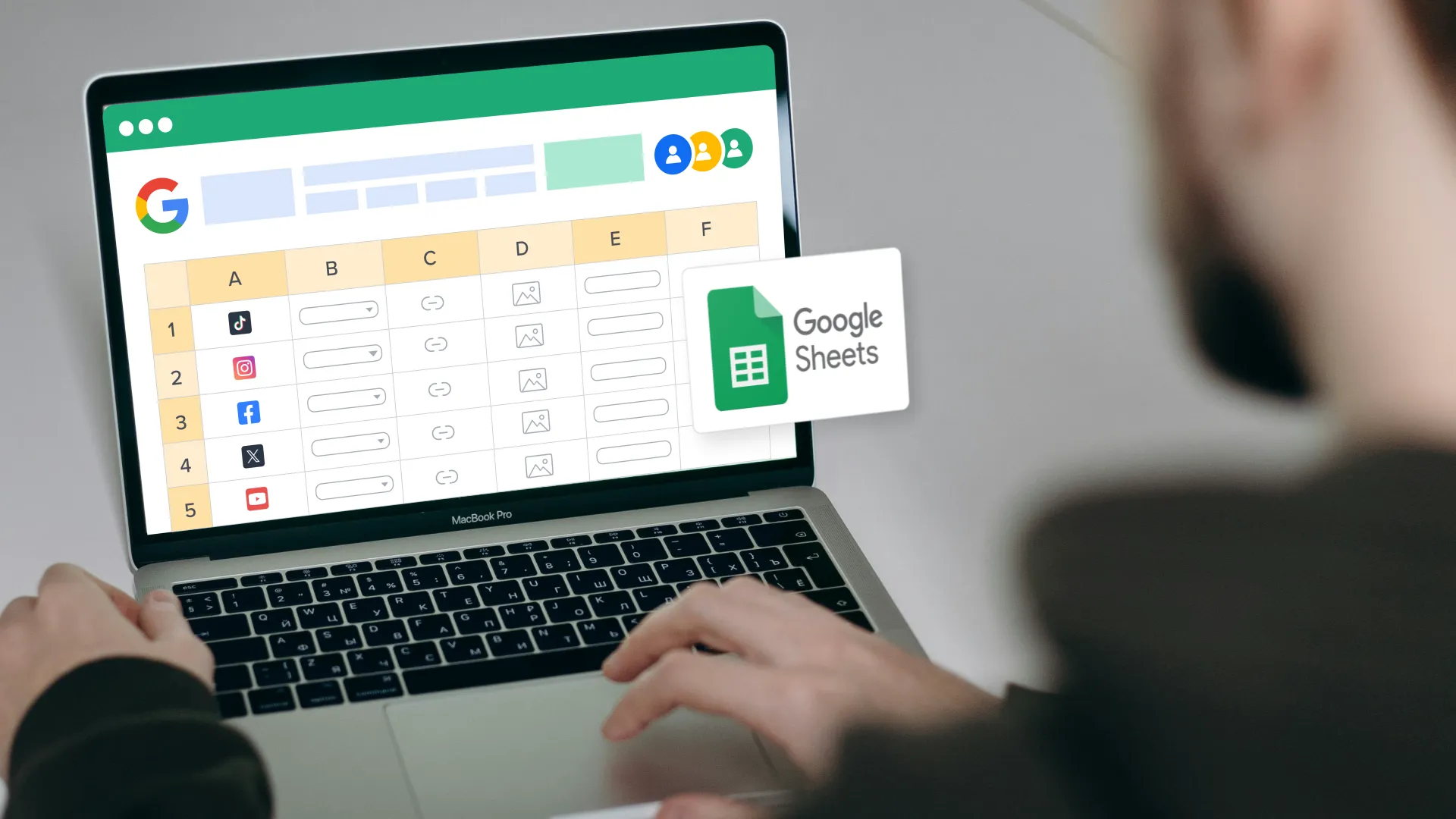A social media calendar is a resource that a social media manager can not live without. It is a medium for them to create a metric ton of content every week, month, and year.
A calendar helps keep our systems and processes in place and eventually attract more engagement; in simple words, it makes social media management freaking easy.
We all know that, but do you know about Google Sheets social media calendar?
Yeah, you heard right—Google Sheets ain’t just for boring spreadsheets anymore. With a little smart work, Google Sheets can help you plan killer posts, stay organized, and keep your followers coming for more.
In this blog, you will learn how to create a social media calendar in Google Sheets with monthly and weekly views and discover some cool tools to enhance your calendar even more.
Why Create a Calendar in Google Sheets?
Imagine you are a social media manager managing multiple platforms and brands at once. Without a proper content calendar, you may miss post publishing, overlook content opportunities, and even accidentally share the wrong post.
Google Sheets is a versatile tool that can help you overcome all these barriers to social media success. We know there are several ways to create a calendar for your social media schedule, but here’s why Google Sheets is a handy solution.
1. It’s Free and Accessible
Social media teams often work under financial restrictions, which means less room for costly tools. This is why Google Sheets is a perfect choice for social media managers who are looking for affordable solutions.
Google Sheets is free, and anyone with a Google account can use it. This makes it the most cost-effective option for creating a social media content calendar and leaves more room to invest in other aspects of content creation.
2. It Helps in Centralized Planning
With Google Sheets, you can overcome the overwhelming feeling of not remembering what content is scheduled when and what is planned next. It provides social media managers with a centralized location for all their plans in an organized hub, providing a comprehensive overview of your entire strategy.
When you create a calendar in Google Sheets, you are able to visualize your content schedule for months at a glance. This bird’s-eye view ensures you never miss out on any upcoming posts or dates.
3. It Keeps Team Synchronized
Being a social media manager means keeping your team on the same page, which is crucial and often challenging. With Google Sheets, you can facilitate real-time collaboration.
You can share your social media content calendar with your team and allow them to edit and update it. Along with that, you can also assign tasks and set deadlines for each task. This helps you keep your team synchronized, reduces the risk of miscommunication, and streamlines the workflow.
4. It’s Customizable
Google Sheets is one such tool that can adapt to your strategy and evolve as you do. Starting with a single grid, it can turn into a complex structure as needed. Add metrics, columns, rows, color codes, and even formulas.
It allows you to create new views and formats for a week, month, or year. Whether you wish to track platforms, content type, status, or give task assignments. It fits well with your unique strategy for any specific needs, along with your workflow.
5. It’s Scalable
As your social media strategy grows with your business, Google Sheets has the ability to offer you the scalability to expand your content calendar; thus, it will grow with your business.
Whether you are moving from managing a handful of content a week to handling multiple campaigns across different platforms, even if you are expanding your team and adding new social channels to your calendar, Google Sheets can support that expansion seamlessly.
Google Sheets is a compatible resource for planning your calendar, whether you work in a start-up or as a social media manager at an industry giant. If you also want to enjoy the benefits of centralization, customization, and affordability, it’s time to create a social media calendar in Google Sheets.
How to Create a Social Media Calendar in Google Sheets?
Whenever creating a Google Sheets social media calendar, you need two types of templates: Monthly and Weekly.
The monthly view will be a visual calendar for your content plan on different platforms for the entire month. The weekly content calendar template will be a detailed schedule defining every minor aspect of the plan, ranging from time to status.
Here’s how to create a monthly calendar in Google Sheets from Scratch:
1. Monthly Social Media Calendar in Google Sheets
A monthly content calendar template is ideal for long-term planning and for visualizing your content plan for the entire month.
TipPlace every text/formula/code in the same cell as given in this guide to troubleshoot easily if something goes wrong.
Step 1: Create a New Google Sheet
The first step is to create a new spreadsheet to make a fresh monthly calendar from scratch.
In the blank sheet, you can start by renaming the sheet to Social Media Content Calendar 2024 and the tab to July 2024.
Here, you can also add another tab as a weekly calendar to be worked on later.

Step 2: Designate a Month and Weekday
Now, it’s time to start preparing your monthly visual calendar by designating a month in the first cell. Then, select and merge all the cells from columns A—G and center and middle-align the text thereafter.

In the next row, place weekdays from column A to G either manually or with the help of Google Sheets formulas to make it dynamic. These formulas are unique recipes that work as a function to complete similar actions all at once.
To fill in the days of the week, double click on the cell and paste this formula “=TEXT(COLUMN(), “DDDD”)” as it is where you want your first weekday to be.

This way, you can specify that you want weekdays to be displayed in the cell. For other days of the week, you can drag the selector from A – G by copying the formula in those cells.

Step 3: Fill in the Date for the Month
Now that we have the month and days of the week, the next step is the dates of the month. You can set up the dates either manually or with the help of a formula to make them dynamic for each month.
For July, it will be from the 1st to the 31st, and the 1st is on Monday. To set up the dates for the dynamic calendar, place the formula “=IFERROR(IF(WEEKDAY($A1)=COLUMN(),1,IF(ABS(A3)>0,A3+1,””)),””)” in the cell below Monday.

This formula represents the first Monday of the month of July. Now, to fill in the dates for the entire week, just drag the selector to column G in the same way you did for weekdays.
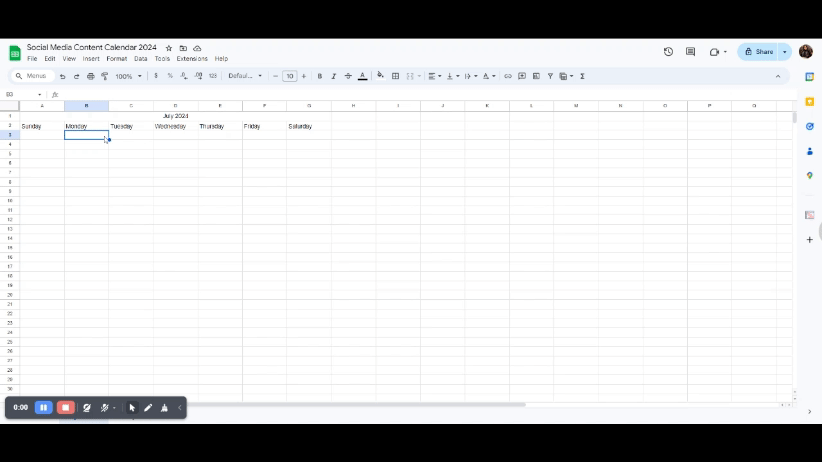
You can repeat this for every week of the month and complete filling in dates, leaving a few rows between every week for the content plan of the day. After doing so, this is how your calendar will look like:
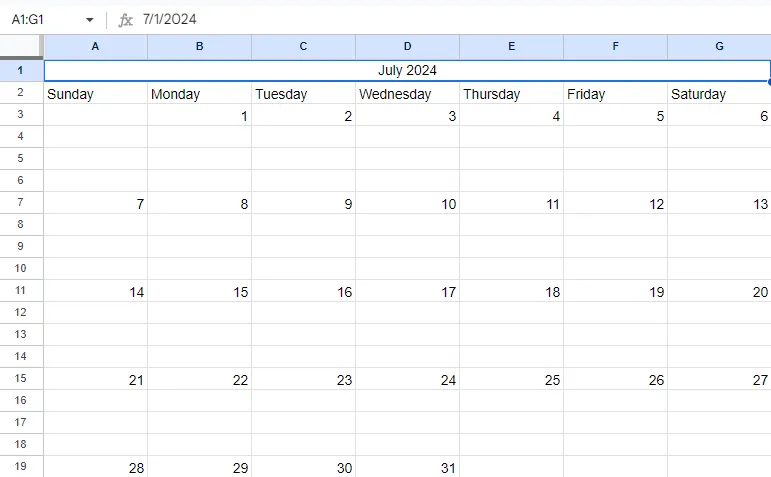
Step 4: Customize Your Calendar with Formatting
The next step is to customize your calendar’s formatting according to your preferences. You can color-code cells to highlight rows or columns for better visual appeal.
Formatting tips:
- The topmost row that contains the name of the Month should have a bigger font size.
- Leave space between each week to mention the content plan for that day.
- Start the week from Sunday.
- Color code cells to highlight them differently.
- Leave two columns to the right of the calendar and remove the rest of the columns; use the key “ctrl+shift+right arrow,” and then delete the selected columns.
- Similarly, remove all the unnecessary rows below the calendar, leaving a few for notes. Use the key “ctrl+shift+down arrow” to delete selected rows.
- Increase the size and font of cells as needed.
- The center and middle align the entire calendar.
- Make borders around different dates and days to separate the view better.
- Freeze above two rows of month and weekdays.
Similar to this, you can also personalize your calendar;
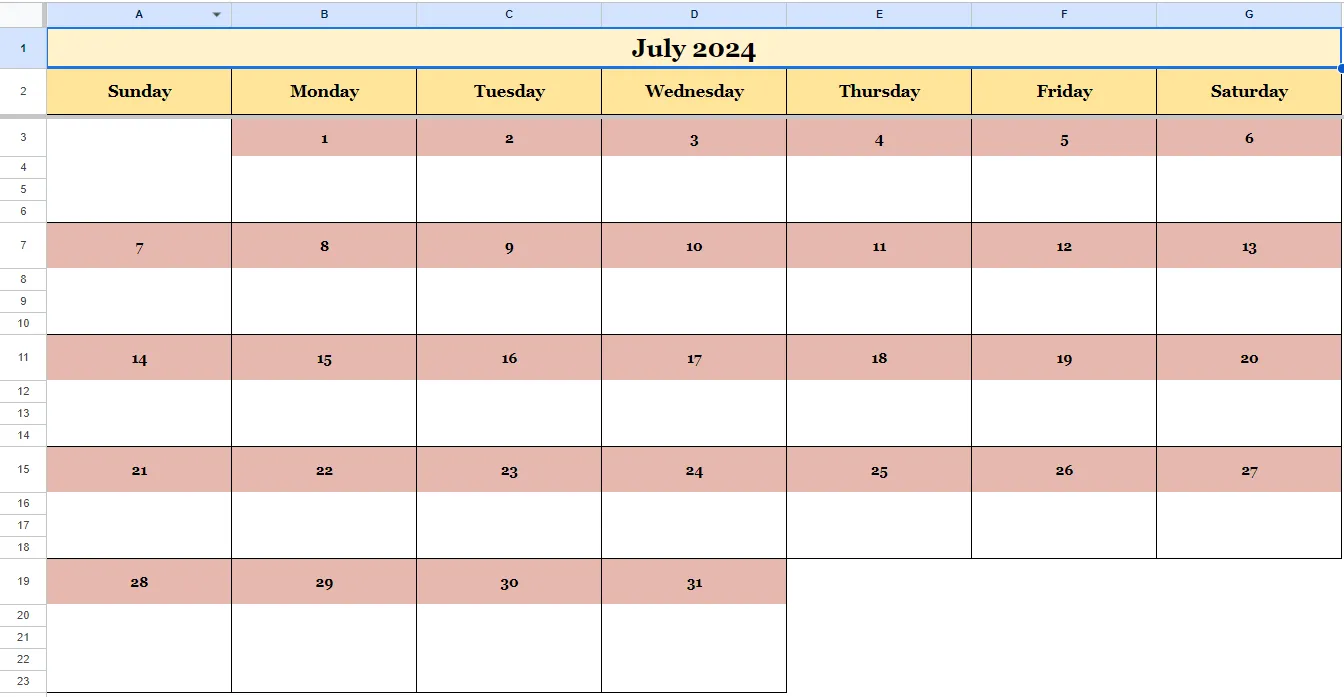
Step 5: Fill in Your Calendar with Content Pillars
So, once you have the calendar skeleton ready, you can finalize your content pillars and schedule and fill in what will go live on which date of the month.
Some key content pillars you can choose are:
- Product Launch
- Evergreen Blog Post
- Curated Content Post
- Q&A
- Blog Post
- User Generated Content
- Tips & Tricks
- Product Launch
- Company Updates
- Recruitment Post
- Quick Tips
- Holiday Post
Separate them with different colors and place them on the visual monthly calendar as per your schedule.
Finally, this is how your monthly visual calendar will look like.
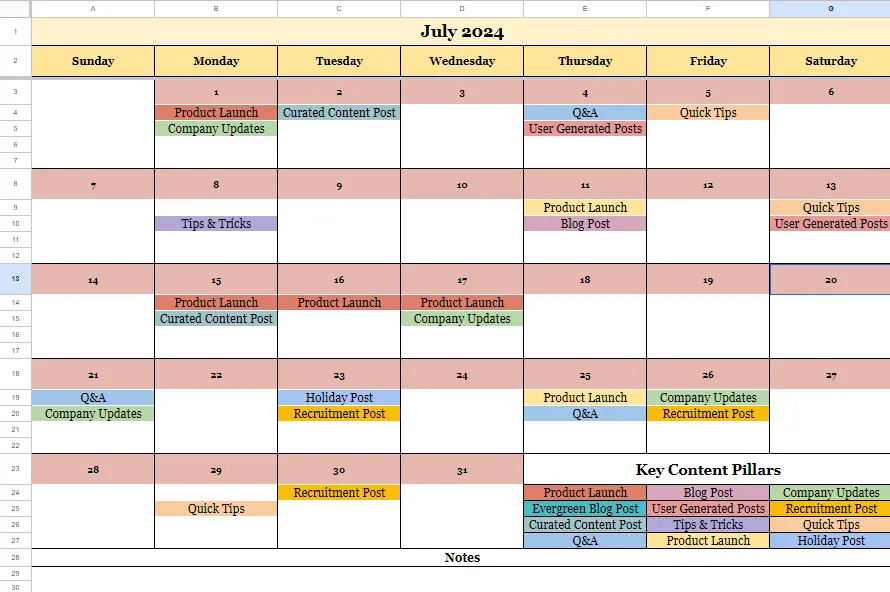
Step 6: Duplicate Calendar for Every Month
When you are done with your entire month’s content plan, and it’s time to plan for the next month, just duplicate the same calendar and start planning ahead.
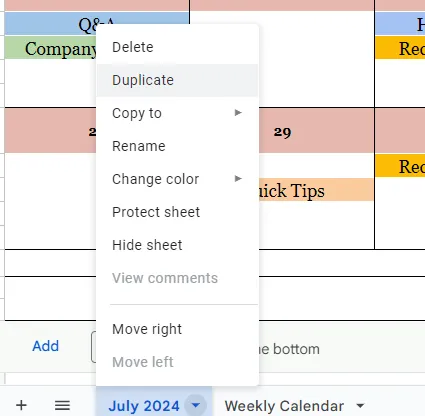
Note: This monthly calendar view is dynamic; it automatically updates as you change the month on the calendar.
2. Weekly Social Media Editorial Calendar in Google Sheets
Google Sheets’s weekly social media content calendar is a detailed view of all your posts for days, dates, and platforms. It is the headquarters of your social media planned schedule.
This weekly social media content calendar template is editorial rather than dynamic and can be customized to be as complex or simple as needed. Here’s how to make a weekly social media content calendar in Google Sheets.
Step 1: Designate a Month and First Week
Open the pre-made tab of the weekly calendar.
In the first cell of the sheet, designate a month and merge cells up to column J. Follow the same for the next row and name it “Week 1.” Increase the font size and bold the text, and this is how your first two rows will look.

Step 2: Set Up the Day, Date, and Time
Designate the first three cells of the next row for day, date, and time. Under the Day column, you can manually mention the seven days of the week.
Similarly, for Date, manually enter the dates of the first week. Do the same for the Time column and mention the time on which you want your post to be published. As you will have more than one post for one day, you can merge the date and day for those rows like this:
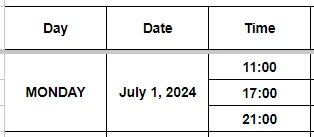
Now you know when which post will go live, and this is how your calendar will look for the week.
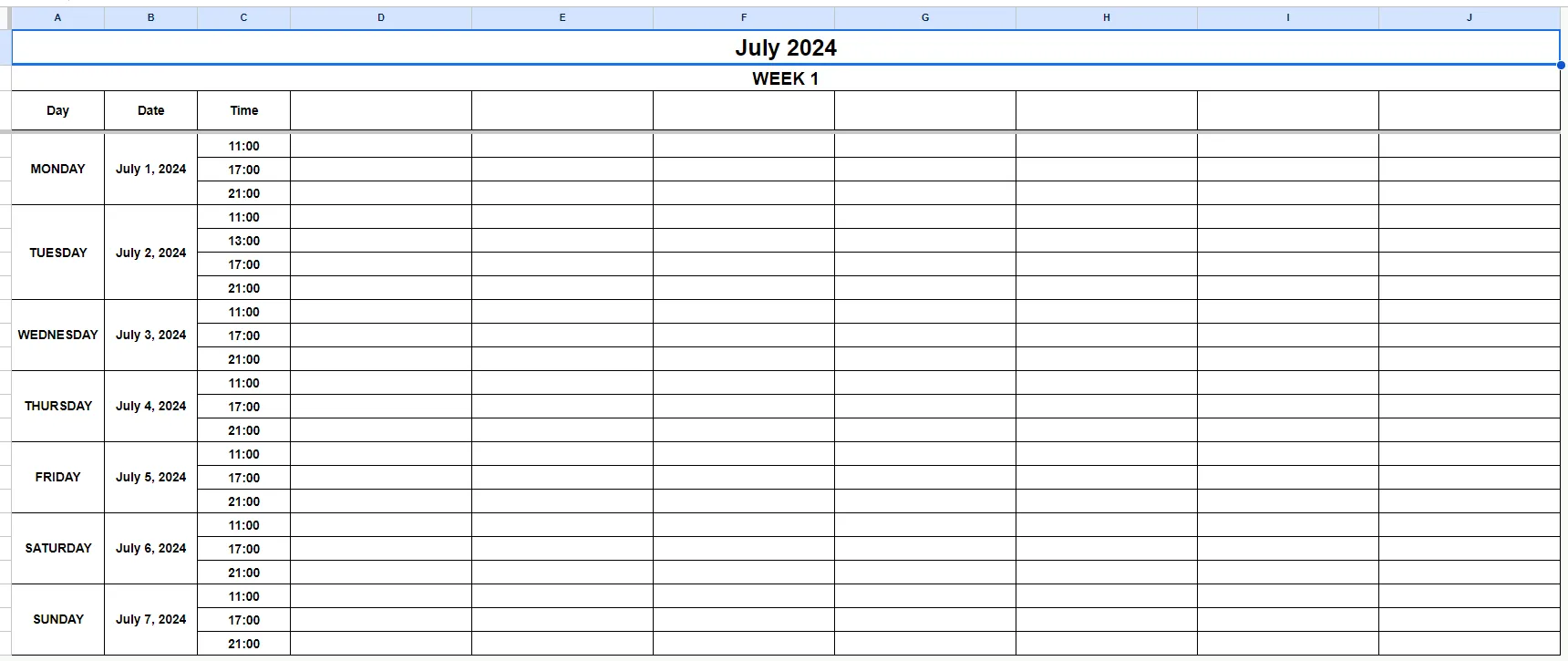
Step 3: Fill in Social Media Calendar Essentials
Essential elements of a social media content calendar include details related to a particular post, such as the post format, on which platform it will be shared, related links, etc.
Key essential elements of a social media content calendar are:
- Day, Date, and Time
- Post Type / Post Format
- Post Description
- Platform
- Media
- URL / UTM
- Campaign
- Goal
Start from the cell next to “Time” and fill in these elements as needed.

The post types/formats you can choose from are:
- Text
- Image
- Video
- Reel
- Pin
- Story
- Carousel
- Live Stream
- Ads
Major social media platforms are:
- YouTube
- TikTok
You can enter these details manually for each post or use a dropdown menu to choose the right option.
Step 4: Format Your Google Sheet Calendar
After preparing your calendar for the week, it is time to format it as you prefer. Color code the rows, resize the text, and create filters so your calendar to enhance the workflow.
Remove excess rows and columns using the “ctrl+shift+right or down arrow.” Merge cells together, freeze columns, and grey out alternate days for a better visual understanding. To make a weekly calendar for all the weeks of the month, you can either duplicate the same in different tabs or extend the same sheets for coming weeks.
This is the final view of our weekly editorial calendar template, which clearly and concisely represents all the aspects of a particular post and helps readers better understand the social media plan for the week.
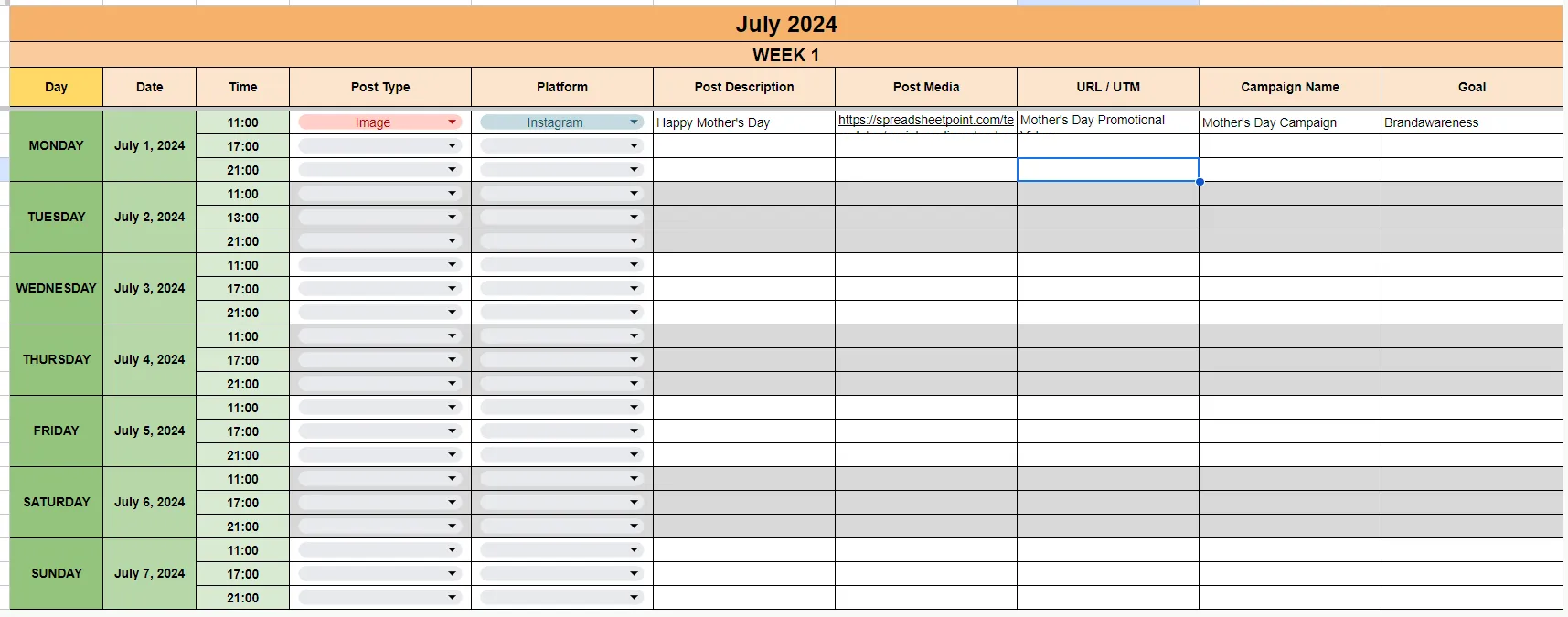
With both monthly and weekly content planners, you can start planning on a positive note, hit high engagement, and improve your online presence.
If you are looking for tools to enhance your social media content planning and execution, we have some for you.
Tools to Enhance Your Google Sheets Social Media Calendar
If you are looking for a method that can help you plan and manage your social media content in a calendar on Google Sheets, here are a few tools for you:
1. SheetGPT
SheetGPT is a great extension for social media managers. This tool integrates with your Google Sheets social media calendar with AI capabilities and automatically generates content according to your commands.
This tool is best used to generate creative and innovative content ideas, fresh captions for your posts, and repetitive tasks with a simple prompt and keywords that you must provide in conditional formatting.
To use SheetGPT in your social media content calendar Google Sheets, follow these steps:
- Step 1: Install the SheetGPT extension from the Google Workspace Marketplace.
- Step 2: Go to your Google Sheets > Extension > SheetGPT > Enable SheetGPT. This will connect your sheet to the GPT model.
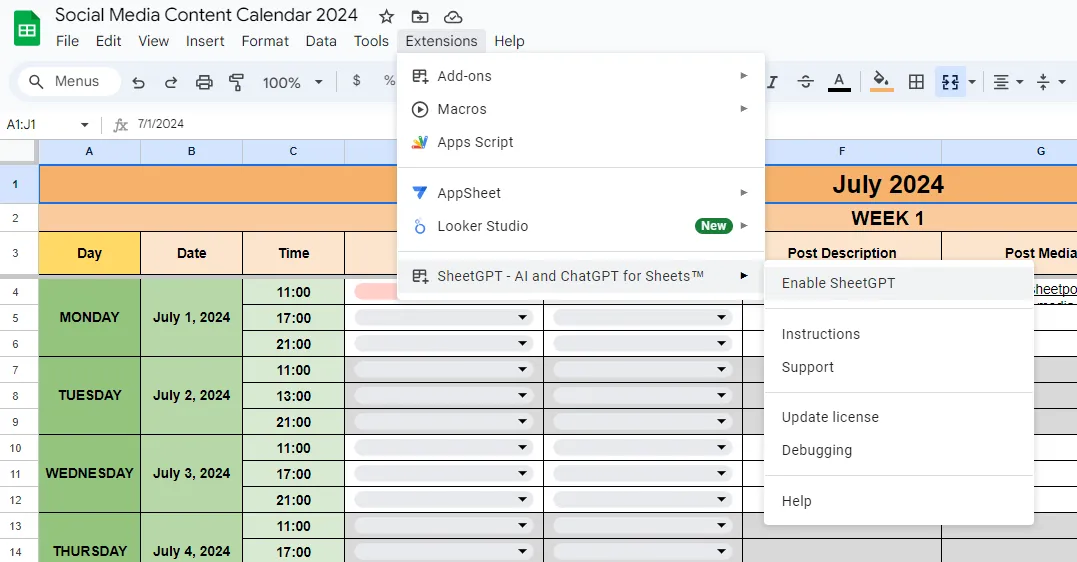
- Step 3: Start using GPT with simple prompts within your social media planner Google Sheets.
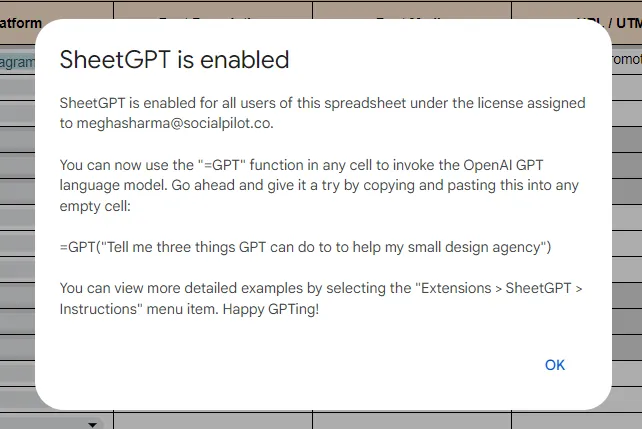
For example: To generate a caption for an Instagram post for a Mother’s Day campaign in your weekly calendar, insert this formula “=if(len(trim(I4))>0,gpt(CONCATENATE(“Write a “,E4,” social media post for tagline: “,I4)),””).” Here, I4 is for the social media campaigns, and E4 is for the platform.
2. Supermetrics
Supermetrics is another handy tool that integrates with Sheets and enhances your social media calendar with better planning. It connects your sheet with various data sources and works as a data importer from multiple channels to your Google Sheets calendar.
This extension is particularly useful when social media managers need to track the performance of their content and make data-driven decisions.
- Step 1: Install the Supermetrics extension and enable it on your Google Sheets via the extension menu.
- Step 2: Launch the sidebar and create a new query.
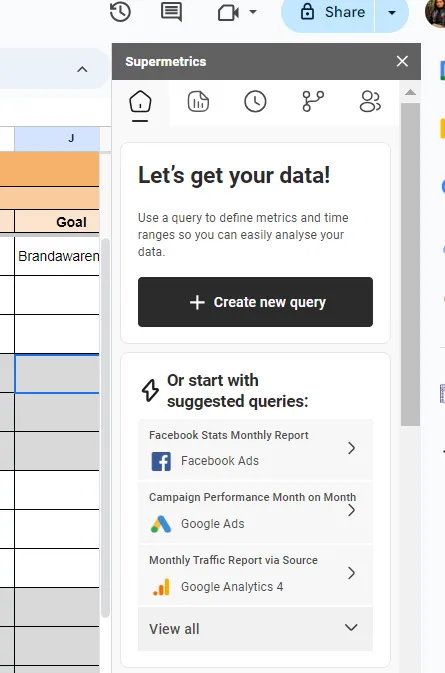
- Step 3: Connect your social media account and customize the data options to focus on relevant metrics. Once done, Supermetrics will input the data into your selected cell.
This is especially useful when you have to share reporting for your recently paid campaign or advertisements.
Common Challenges of Using Google Sheets for Social Media Calendars
- One of Sheet’s biggest limitations is manual data entry, which requires you to fill in every detail yourself.
- Google Sheets does not have the capability to automate your calendar.
- As you multiply your calendar plan month after month, it becomes difficult for Google Sheets to handle that data.
- Creating a dynamic calendar in Sheets involves complex formulas, which are difficult for a non-technical person to understand.
- Google Sheets offers limited ability to manage team members’ tasks, which makes it less effective for coordination.
- Minimal integration to third-party tools or platforms and required manual data transfer.
- Sorting out content based on filters can be daunting in Google Sheets.
- It gets confusing to make and manage content across multiple social media platforms within Sheets.
- Google Sheets are not accessible on mobile devices and often become less optimum.
- Analytics and performance tracking are not available in Google Sheets, which reduces the impact of social media marketing efforts while planning.
- Making a personalized calendar in Sheets takes a lot of details and functional efforts that are time-consuming.
- In Sheets, there is no way to preview the post to know how it will appear after publishing social media content.
- Google Sheets does not have the feature to set up personalized notifications and alerts to remind you of deadlines, tasks, and upcoming posts.
The above factors identify the inability of Google Sheets to cater to the success of a social media content calendar. These issues highlight why a specialized social media calendar might be a better fit to perform better for your content schedule.
Google Sheets Alternatives for Social Media Content Calendar
Here are two alternatives for making a social media planner Google Sheets, which can save you time, help you plan better, and ensure optimum organization.
Free Content Calendar Template Google Sheets
If you don’t want to go through the hassle of making a calendar in Sheets and want a premade content calendar template, we have it for you. Our free template provides a dynamic monthly visual calendar view and a customizable weekly view.
It will save you from the daunting task of making a new calendar every month with filters and formatting by giving you a free social media calendar template Google Sheets, that you can customize according to your needs. You can even integrate SheetGPT and Supermetrics within this template.
So just download the content calendar template from below and let it do the hard work for you.
SocialPilot Social Media Calendar Tool
SocialPilot is a comprehensive tool that helps you manage your social media content in an intuitive visual calendar. It overcomes all the limitations of Google Sheets and works as a feature-packed resource for social media managers.
Some most popular calendar features that make SocialPilot the best social media calendar tool are:
- Unlimited Scheduling
- Easy-to-Use UI
- Auto-Filled Calendar
- Can Handle Years of Date
- Notification and Alerts
- Color-coded Calendar Notes
- Customizable Daily, Weekly, Monthly View
- Drag and Drop to Any Time Slot
- Preview Scheduled Posts
- Schedule for Multiple Accounts
- Delete Published Posts
- Collaborate with Team on Drafts
- Schedule Drafts by Date
- Holiday and Special Day Indication
- Know Content Status
- Easy to Filter Post Type
- Quick Clarity of Post Type
- Add, Delete, or Edit Colour-coded Post Tags
- Post Approval Workflow
- Reshare Existing Posts
- Event and Campaign Planning
- Advanced Search and Filter
- Historical View of Posted Content
- Identify Target Audience
- Minimum Pricing
This proves that the intuitive SocialPilot social media calendar allows you to better organize, visualize, and analyze your social media efforts and maximize their potential.
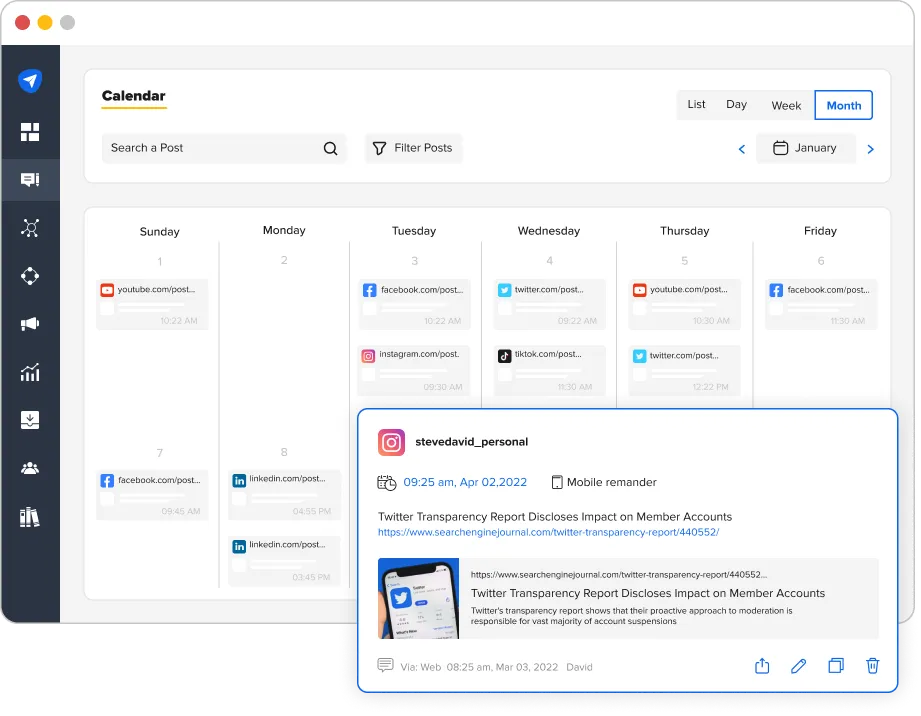
So, what are you waiting for? Start your free trial today!
To Wrap It Up!
Google Sheets is a popular tool for social media planning and organizing different types of posts, and with a few add-ons, you can even improve that experience. However, even the best tools have limitations.
If above given Google Sheets social media calendar constraints bother you, try investing your efforts in a fully dedicated content calendar tool for social media or free content calendar templates specially designed to meet all your calendar needs.
By choosing the right resource, you can manage content for multiple platforms, maximize your social media marketing efforts with clarity, and achieve expected business goals.

